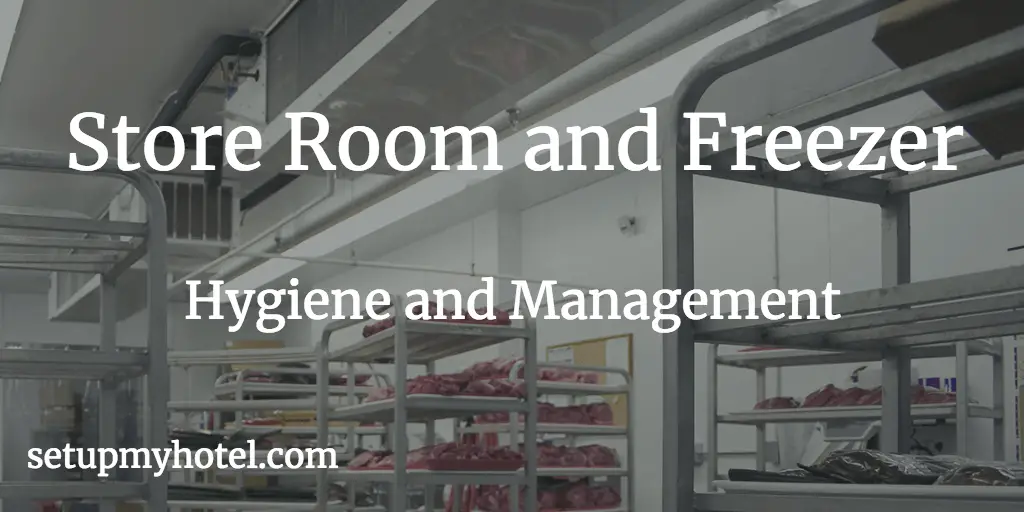Store Room and Freezer Hygiene and Management
The standard operating procedures (SOP) for a kitchen or food and beverage production area include guidelines for the store room and freezer. Proper hygiene and management are also essential components of the SOP.
In the storeroom, all food items should be properly labelled and stored at the appropriate temperature to prevent spoilage. Items should be stored in a first-in, first-out (FIFO) manner to ensure that older items are used before newer ones. The store room should be kept clean and organized, with regular checks for expired or damaged items.
The freezer should be kept at the proper temperature to prevent the growth of bacteria and other harmful organisms. Frozen items should be properly labelled with the date of freezing and the expiration date. The freezer should be regularly defrosted and cleaned to prevent the buildup of ice and debris.
Hygiene is of utmost importance in a kitchen or food production area. All staff should wash their hands regularly and wear clean, appropriate clothing. Surfaces and equipment should be regularly cleaned and sanitized to prevent the spread of bacteria and other harmful organisms.
Effective management is also crucial in ensuring the smooth operation of a kitchen or food production area. This includes proper staff training, scheduling, and communication. Regular inspections and audits can help identify areas for improvement and ensure compliance with SOPs and food safety regulations.
To store all goods in the appropriate hygienic and secured area, with all stock securely issued and regularly checked. All Kitchen staff should work together to achieve the kitchen hygiene standard.
The Executive Chef should be responsible for monitoring and auditing the freezer and storeroom management and hygiene systematically and to ensure a consistently high specification of product sourced. The hotel management should develop and implement written storage management specifications to ensure purchased products are stored and distributed correctly.
Kitchen Freezer and Storage Management Standard Procedures:
1) How can the kitchen storerooms provide a hygienic storage environment?
- Storerooms and equipment should be kept clean on an ongoing basis; regular deep cleaning is implemented.
- The storage area is always kept dry, cool, and well-ventilated.
- All cardboard boxes/packaging are disposed of correctly.
- Correct temperatures are maintained at all times.
- Adequate pest control measures should be in place.
- Dry goods are stored at least 0.20 meters above the floor on pallets and shelving.
- Fats and oils are stored away from strong-smelling foods.
- Goods are properly arranged and displayed.
2) How to adhere to safe storage conditions in the HotelA Hotel or Inn may be defined as an establishment whose primary business is providing lodging facili... Kitchen?
- Storerooms have sufficient space and storage shelving for the quantities of stock held.
- Storerooms have adequate lighting for safe access/use.
- Cleaning agents are stored in a safe, cool, and dry place away from heat sources.
- Separate storage areas are allocated for toxic and non-toxic items.
- Cases are not stacked too high and are easily accessible.
- Storerooms are locked when not in use.
3) How to ensure efficient and effective storage of stock?
- All received items from the main store are stored by product.
- Stock rotation by following the FIFO method is strictly adhered to.
- All perishable goods are kept in a cool, dry place.
4) How to ensure that deep freeze storage is safe and hygienic?
- Deep freezers are maintained at or below -18°C, (ice cream at -12°C for up to one week).
- Deep freezes should be regularly defrosted and cleaned.
- Raw and cooked foods are stored in separate freezers to prevent cross-contamination.
- All frozen food should be wrapped with foil or plastic wrap, to prevent freezer burn.
- Temperature checks are taken regularly and thermometers are checked for accuracy.
- Freezers are not overloaded and the door is not kept open any longer than is necessary.
5) How to store refrigerated items safely and hygienically?
- Refrigerated stores are maintained between -1°C and 5°C (ideally less than 3°C).
- Fridges are deep cleaned regularly and tidied daily.
- Fridges are free from bad odours at all times.
- Fans are clean, free from ice, and working correctly.
- Food is placed on labelled trays and properly stored.
- The fridge gas is checked every 3 months.
- Cooked or ready-to-eat foods are not stored in the same refrigerator as raw foods unless covered and segregated.
- Raw food is not stored above cooked or ready-to-eat foods.
- High-risk foods and prepared vegetables are stored in refrigerated storage or a deep freezer.
Training Summary questions:
Q1. What is the purpose of this SOP?
Q2. Who is responsible to check and monitor purchasing activities in the kitchen?
Q3. Explain why it is important to purchase items from approved vendors.
Q4. What is the standard for purchasing dairy products in the kitchen?
Q5. Why is this an important tip for the employees who are responsible for purchasing?
Patreon Only SOP Download
SOP Number: Kitchen / F&B Production SOP – 9 Department: Kitchen / Food Production - Store Room and Freezer Management Date Issued: 21-Sep-2018 Time to Train: 30 Minutes












